Si Avalanche Photodetectors
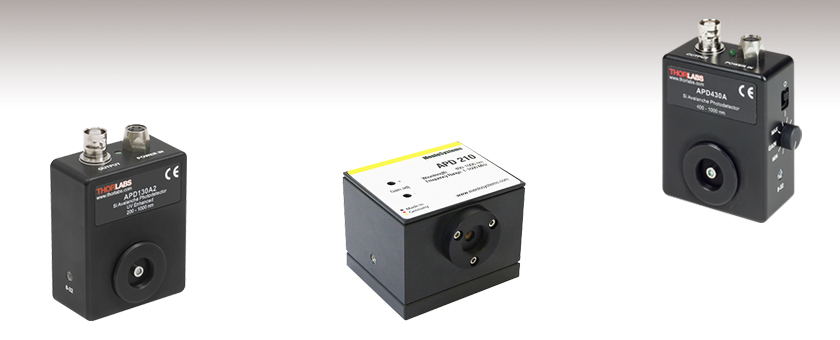
- High-Speed Response Up to 1 GHz
- Conversion Gains up to 2.65 × 109 V/W
- Wavelength Range of 200 - 1000 nm or 400 - 1000 nm
- Temperature-Compensated and Variable-Gain Versions Available
APD210
High-Speed APD
APD130A2
Temperature-Compensated APD
APD430A
Variable-Gain,
Temperature-Compensated APD

Please Wait
| Si APD Selection Guide | |||
|---|---|---|---|
| Item # | Wavelength Range |
Bandwidth (3 dB) |
Type (Quick Links) |
| APD130A2(/M) | 200 - 1000 nm | DC - 50 MHz | Temperature Compensated |
| APD130A(/M) | 400 - 1000 nm | ||
| APD440A2 | 200 - 1000 nm | DC - 0.1 MHz | Variable Gain, Temperature Compensated |
| APD410A2(/M) | DC - 10 MHz | ||
| APD430A2(/M) | DC - 400 MHz | ||
| APD440A | 400 - 1000 nm | DC - 0.1 MHz | |
| APD410A(/M) | DC - 10 MHz | ||
| APD430A(/M) | DC - 400 MHz | ||
| APD410 | 200 - 1000 nm | 5 - 900 MHz | Variable Gain, Temperature Compensated, High Speed |
| APD210 | 400 - 1000 nm | 5 - 1000 MHz | |
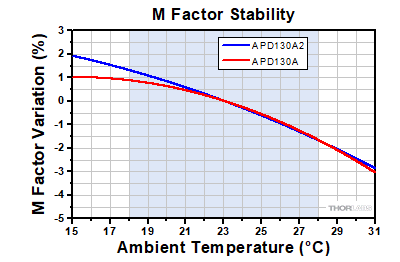
Click to Enlarge
The above plot shows the M factor stability of our temperature-compensated avalanche photodetectors. The blue shaded region indicates the temperature range over which the M factor stability is guaranteed to within ±3%.
Features
- Noise Equivalent Powers (NEP) as Low as 2.5 fW/√Hz
- Max Bandwidth Up to 1 GHz at 3 dB
- Temperature-Compensated Versions Provide M Factor Stability of ≤±3% Over 18 to 28 °C
- Variable Gain Detectors Available: M Factor from 5 to 50 or 10 to 100
- Internal SM05 and External SM1 Threading for Lens Tubes
- Power Supply Included
Thorlabs' Silicon Avalanche Photodetectors (APD) are designed to offer increased sensitivity and lower noise compared to standard PIN detectors, making them ideal for applications with low optical power levels. In addition to our standard APDs, versions featuring variable gain (i.e., M factor) and/or temperature compensation are offered.
In general, avalanche photodiodes use an internal gain mechanism to increase sensitivity. A high reverse bias voltage is applied to the diodes to create a strong electric field. When an incident photon generates an electron-hole pair, the electric field accelerates the electrons, leading to the production of secondary electrons by impact ionization. The resulting electron avalanche can produce a gain factor of several hundred times, described by a multiplication factor, M, that is a function of both the reverse bias voltage and temperature. In general, the M factor increases with lower temperatures and decreases with higher temperatures. Similarly, the M factor will increase when the reverse bias voltage is raised and decrease when the reverse bias voltage is lowered.
Our APD130A2(/M) and APD130A(/M) temperature-compensated APDs feature integrated thermistors that adjust the bias voltage to compensate for the effect of temperature changes on the M factor. A comparison with our non-temperature-compensated APDs is provided in the graph to the right.
In addition to being temperature compensated, our variable-gain APD400 series detectors allow the reverse bias voltage across the diodes to be adjusted via a rotary knob on the side of the housing, which varies the M factor from 5 to 50 or 10 to 100.
Thorlabs offers Menlo Systems' APD410 and APD210 Variable-Gain Avalanche Photodetectors, which offer high-speed responses up to 900 MHz or 1 GHz at 3 dB, respectively. Additionally, we offer spectral-flattening filters that are designed to improve the response uniformity of our silicon photodiodes and detectors; click here to learn more.
A complete list of all of our APDs, including those that have an InGaAs photodiode for use at IR wavelengths, can be found on the Selection Guide tab. Please note that these packaged APDs are not suitable for use as single photon counters. Thorlabs has single photon counters available here.
Click on the yellow boxes below to view specifications for each type of photodetector.
Temperature-Compensated Si Avalanche Photodetectors
All technical data are valid at 23 ± 5 °C and 45% ± 15% relative humidity (non-condensing).
| Item # | APD130A2(/M) | APD130A(/M) |
|---|---|---|
| Detector Type | UV Enhanced Silicon APD |
Silicon APD |
| Wavelength Range | 200 - 1000 nm | 400 - 1000 nm |
| Output Bandwidth (3 dB) | DC - 50 MHz | |
| Active Area Diameter | 1 mm | |
| Typical Max Responsivity | 25 A/W @ 600 nm (M = 50) |
25 A/W @ 800 nm (M = 50) |
| M Factora,b | 50 | |
| M Factor Temperature Stabilityc | ±2% (Typical); ±3% (Max) |
±2% (Typical); ±3% (Max) |
| Transimpedance Gain | 50 kV/A with 50 Ω Terminationd 100 kV/A for High-Impedance Termination |
|
| Max Conversion Gaine,f | 2.5 x 106 V/W | |
| CW Saturation Power | 1.5 µW | |
| Max Input Powerg | 1 mW | |
| Minimum NEP (DC - 50 MHz)e,h |
0.21 pW/√Hz | 0.20 pW/√Hz |
| Integrated Noise (DC - 50 MHz) |
1.4 nW (RMS) | 1.5 nW (RMS) |
| Electrical Outputs | 50 Ω BNC | |
| Max Output Voltage | 1.8 V with 50 Ω Termination 3.6 V with High-Impedance Termination |
|
| DC Offset Electrical Output | <±15 mV | |
| Power Supplyi | ±12 V @ 250 mA (100/120/230 VAC, 50 - 60 Hz, Switchable) |
|
| General | ||
| Operating Temperature Range | 0 to 40 °C (Non-Condensing) | |
| Storage Temperature Range | -40 to 70 °C | |
| Device Dimensions (H x W x D) |
75.5 mm x 50.8 mm x 27.4 mm (2.97" x 2.00" x 1.08") |
|
| Weight | <0.1 kg | |
Variable-Gain, Temperature-Compensated Si Avalanche Photodetectors
All technical data are valid at 23 ± 5 °C and 45% ± 15% relative humidity (non-condensing).
Variable-Gain, Temperature-Compensated, High-Speed Si Avalanche Photodetectors
| Item # | APD410 | APD210 |
|---|---|---|
| Detector Type | Si APD | |
| Optical Input | Free Spacea | |
| Wavelength Range | 200 - 1000 nm | 400 - 1000 nm |
| Damage Threshold | 10 mW | 10 mW |
| Active Area Diameter | 0.2 mm | 0.5 mm |
| Frequency Range | 1 MHz - 1600 MHz | |
| 3 dB Bandwidth | 5 MHz - 900 MHz | 5 MHz - 1000 MHz |
| Rise Time | 500 ps | 500 ps |
| Conversion Gain (Max)b | 4.5 x 104 V/W @ 650 nm | 2.5 x 105 V/W @ 800 nm |
| NEP (Calculated)c | 87.6 pW/√Hz | 0.24 pW/√Hz |
| Dark State Noise Leveld | -80 dBm | |
| M Factor | 50 | 100 |
| Typical Max Responsivity | 22 A/W @ 650 nm | 50 A/W @ 800 nm |
| Output Impedance | 50 Ω | |
| Output Connector | BNC | |
| Output Coupling | AC | |
| Current Consumption (Max) | 200 mA | |
| Supply Voltagee | +12 to +15 V | |
| Operating Temperature | 10 to 40 °C | |
| Storage Temperature | -20 to +85 °C | |
| Storage Humidity | 10% - 90% RH | |
| Device Dimensions | 60 mm x 50 mm x 47.5 mm (2.36" x 1.97" x 1.87") |
|
BNC Female Output (Photodetector)
APD Male (Power Cables)
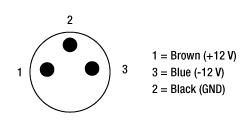
APD Female (Photodetector)
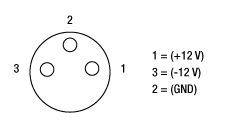
| Components for Fiber Coupling | |
|---|---|
| Item # | Description |
| - | Avalanche Photodetector |
| LM1XY(/M) | Translating Lens Mount for Ø1" Optics |
| SM1L10 | SM1 (1.035"-40) Lens Tube, 1" Long |
| - | Fiber Collimator (Dependent on Fiber) |
| AD11F or AD12F | SM1-Threaded Adapters for Ø11 or Ø12 mm Fiber Collimators (Dependent on Collimator) |
| - | Mounted Molded Aspheric Lens (Dependent on Collimator) |
| S1TM06, S1TM08, S1TM09, S1TM10, or S1TM12 |
SM1-Threaded Adapter for Molded Aspheric Lens Cell (Dependent on Lens) |
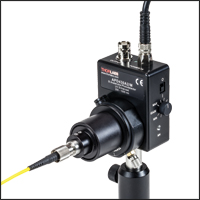
Click to Enlarge
Output from a fiber is coupled into the photodetector using an aspheric lens to focus the signal onto the detector active area.
Fiber Coupling
In fiber coupling applications, we recommend taking into account the divergence of light from the fiber tip to ensure that all of the signal is focused onto the detector active area. When using a standard fiber connector adapter with a detector with an active area smaller than Ø1 mm, high coupling losses and degradation of the frequency response may occur.
To achieve high coupling efficiency, a fiber collimation package, focusing lens, and X-Y translator should be used, as shown in the photo to the right. The avalanche photodetector is shown with a fiber collimator, lens tube collimator adapter, lens tube, and X-Y translation mount. An adapter inside the lens tube holds an aspheric lens (not visible) to focus the collimated light onto the active area of the detector. The X-Y translation mount corrects for any centering issues.
Pulsed Laser Emission: Power and Energy Calculations
Determining whether emission from a pulsed laser is compatible with a device or application can require referencing parameters that are not supplied by the laser's manufacturer. When this is the case, the necessary parameters can typically be calculated from the available information. Calculating peak pulse power, average power, pulse energy, and related parameters can be necessary to achieve desired outcomes including:
- Protecting biological samples from harm.
- Measuring the pulsed laser emission without damaging photodetectors and other sensors.
- Exciting fluorescence and non-linear effects in materials.
Pulsed laser radiation parameters are illustrated in Figure 1 and described in the table. For quick reference, a list of equations are provided below. The document available for download provides this information, as well as an introduction to pulsed laser emission, an overview of relationships among the different parameters, and guidance for applying the calculations.
|
Equations: |
||||
 |
and |  |
||
 |
||||
 |
||||
 |
||||
Peak power and average power calculated from each other: |
||||
 |
and |  |
||
| Peak power calculated from average power and duty cycle*: | ||||
 |
*Duty cycle ( ) is the fraction of time during which there is laser pulse emission. ) is the fraction of time during which there is laser pulse emission. |
|||
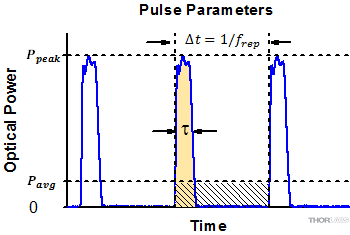
Click to Enlarge
Figure 1: Parameters used to describe pulsed laser emission are indicated in the plot (above) and described in the table (below). Pulse energy (E) is the shaded area under the pulse curve. Pulse energy is, equivalently, the area of the diagonally hashed region.
| Parameter | Symbol | Units | Description | ||
|---|---|---|---|---|---|
| Pulse Energy | E | Joules [J] | A measure of one pulse's total emission, which is the only light emitted by the laser over the entire period. The pulse energy equals the shaded area, which is equivalent to the area covered by diagonal hash marks. | ||
| Period | Δt | Seconds [s] | The amount of time between the start of one pulse and the start of the next. | ||
| Average Power | Pavg | Watts [W] | The height on the optical power axis, if the energy emitted by the pulse were uniformly spread over the entire period. | ||
| Instantaneous Power | P | Watts [W] | The optical power at a single, specific point in time. | ||
| Peak Power | Ppeak | Watts [W] | The maximum instantaneous optical power output by the laser. | ||
| Pulse Width |  |
Seconds [s] | A measure of the time between the beginning and end of the pulse, typically based on the full width half maximum (FWHM) of the pulse shape. Also called pulse duration. | ||
| Repetition Rate | frep | Hertz [Hz] | The frequency with which pulses are emitted. Equal to the reciprocal of the period. | ||
Example Calculation:
Is it safe to use a detector with a specified maximum peak optical input power of 75 mW to measure the following pulsed laser emission?
- Average Power: 1 mW
- Repetition Rate: 85 MHz
- Pulse Width: 10 fs
The energy per pulse:

seems low, but the peak pulse power is:

It is not safe to use the detector to measure this pulsed laser emission, since the peak power of the pulses is >5 orders of magnitude higher than the detector's maximum peak optical input power.
| Posted Comments: | |
Gerald Auböck
(posted 2024-02-23 08:07:42.433) Hi,
do you by chance have data on the linearity of your
APD130A (except for the saturation power). Maybe dependent on gain setting.
Thanks, Gerald hkarpenko
(posted 2024-02-23 10:55:57.0) Dear Gerald,
thank you for your feedback.
These detectors are very linear up to the saturation power. I will have to check with our development team, whether we can share test data for these. I will contact you directly to discuss this topic further with you. Gerald Auböck
(posted 2024-02-23 08:06:49.84) Hi,
do you by chance have data on the linearity of your
APD130A (except for the saturation power). Maybe dependent on gain setting.
Thanks, Gerald dpossin
(posted 2024-02-27 04:12:21.0) Dear Gerald,
Thank you for your feedback. In general our photodiode based sensors provide a linearity of around 0.1% but the overall linearty will be limited by the temperature compensation which is in between 3 and 5%. Jay Lin
(posted 2023-11-29 11:29:44.647) These APD only need 12V bias to work? Isn't APD suppose to have a High Voltage supply? hkarpenko
(posted 2023-11-29 11:45:58.0) Dear Jay,
thank you very much for your feedback.
You are correct, that inside the APD there will built up a high bias voltage to induce the avalanche effect. However this high voltage is generated due to the circuitry of the APD and not needed to be generated externally by a high voltage power supply. user
(posted 2022-12-30 14:23:03.053) I have purchased lens assembly for fiber coupling for APD430A2.
The collimator F240FC-A and aspheric lens A280TM-A. I believe the one thread end of aspheric lens mount S1TM09 has to be mounted on the APD's thread and LM1XY on the other end of the thread. The lens tube can be mounted on the LMXY's other end. Further collimator mount on the other end of lens tube. Can you confirm the above placement of these lenses? The description in site says that aspheric lens is inside lens tube. Because S1TM09 is a thread to thread adapter, it cannot be inside the lens tube. fmortaheb
(posted 2023-01-02 08:14:12.0) Thank you very much for contacting Thorlabs. You can use the S1TM09 to mount the lens inside the lens tube. The SM1 thread on the S1TM09 is matching with the internal SM1 thread of the lens tube. I will contact you directly to discuss your application further. Eric Miller
(posted 2022-12-01 19:02:33.64) I'm using the UV-enhanced APD430A2. Do you have any advice on long-term UV operation with this APD close to the CW saturation limit? We've observed a 20x decrease in responsivity after several hundred hours operation at 250nm . Our tests on a unused replacement with a 8uW CW beam showed a decrease in responsivity of 0.5% per minute. Also can you clarify how the saturation power depends on wavelength at 250nm? We thought it should be higher than 8uW based on the lower responsivity at that wavelength. Thanks! hkarpenko
(posted 2022-12-02 09:10:13.0) Dear Eric,
thank you very much for your feedback.
Unfortunately we have not measured the degradation for this wavelength specifically. The saturation power can be estimated using the formula described in the manual on p.7.
I will reach out to you directly to discuss this case further. user
(posted 2022-10-24 14:21:26.803) I am an Indian user. I have bought APD 440A and 430A2 recently. European power cable is provided. Do you recommend using an UK to Indian adapter or an Indian power cable of same rating (250V , 16A) ? hchow
(posted 2022-10-25 06:04:46.0) Dear User, thank you for your enquiry.
I believe what you are looking for is "India type D to C13" power cord.
I will reach out to you privately for more information. hchow
(posted 2022-10-25 08:32:21.0) Thank you and have a nice day! user
(posted 2022-06-23 09:53:40.53) Hi, I am wondering about the time response (rise and fall time) of the APD430A and APD430A2 (400MHz bandwidth) models and the two Menlo APD410 and APD210 (1GHz) models.
I want to perform time resolved fluorescence with expected lifetimes of several nanosecond or longer.
What is the minimum decay time you can measure with those models? The APD410 and APD210 should have better rise/fall time, but the time response curves to fs pulse contain some ripples (see the menlo datasheet). What about the APD430A and _A2? Can you provide their response curve to ps or ns pulse?
Also, do you recommend those SiAPD or PMT for measuring fluorescence decay curves with nanosecond lifetimes? dpossin
(posted 2022-07-01 07:35:33.0) Dear Felice,
Thank you for your feedback. I reach out to you in order to provide information about that. user
(posted 2022-05-02 15:49:02.99) I am planning to buy APD440A and a fiber connector
adapter S120-FC2 which can connect to FC/PC 2mm narrow key end of a multimode fiber of core/clad as 200/220um. Is the power supply included with detector? Is there any other holding or mounting/screws options I need to buy with this?? I am doing a fiber-based experimental setup. Please suggest.
I am also planning to buy APD430A2 which has a smaller active area. Can you suggest a compatible fiber collimator, lens tube collimator adapter, lens tube, and X-Y translation mount ? wskopalik
(posted 2022-05-05 08:49:11.0) Thank you very much for your feedback!
I will contact you directly to provide assistance with the selection of the necessary components. yiming zang
(posted 2022-04-26 21:12:08.243) I want to know the sampling rate of the APD130A2/M.
Thanks! Jean Matias
(posted 2022-04-22 09:14:19.923) Hi,
I was wondering if you could send me the data for the APDs responsivity used to make the plots available here on the website.
Best,
Jean Matias mdiekmann
(posted 2022-04-25 06:30:05.0) Thank you for reaching out! We will contact you directly to share the requested data. Chen Kuo
(posted 2021-03-12 16:02:12.41) Dear manager,
Can you send me the relevant materials of APD120A/M? Because I am very interested in this equipment, I need to check the materials and experimental equipment that can be used for research.
Thank you. soswald
(posted 2021-03-18 04:02:49.0) Dear Chen Kuo,
thank you for your feedback. Unfortunately the exact parts list of the APD120A/M is proprietary information, but I have reached out to you directly to evaluate which information you need and what we can provide. Peter Meinhold
(posted 2020-12-22 00:31:31.11) We're using these APDs in our OEM instrument prototype, but we really want to be able to control the transimpedance gain electronically- is there any product that allows that, with similar NEP to the APD440A2? dpossin
(posted 2020-12-22 04:38:21.0) Dear Peter,
Thank you for your feedback. I am reaching out to your in oder to discuss opportunities. Thomas Price
(posted 2020-10-19 19:22:58.53) I'm using the APD410A detector and have a question on the noise floor. According to the spec sheet, the integrated noise is 130 pW based on the NEP from DC-10MHz. When I use the detector, I'm seeing a noise floor of 4.88 nW at rougly 20MHz. Do I need additional electrical filtering to attain the noise levels quoted in the specifications? MKiess
(posted 2020-10-22 06:42:55.0) Dear Thomas, thank you very much for your inquiry.
The listed NEP value is only valid for the specified frequency range. The measurement bandwidth must be less than or equal to that frequency range. If the measurement bandwidth exceeds that range,the NEP needs to be adjusted. However, this will increase the NEP significantly.
Furthermore the NEP value depends on the wavelength. The NEP value given in the Specs is the minimum NEP. Therefore the value has to be adjusted when using another wavelength. For more information on how NEP is calculated, please see Thorlabs' Noise Equivalent Power White Paper, which can be found using the follwoing link:
https://www.thorlabs.de/images/TabImages/Noise_Equivalent_Power_White_Paper.pdf
I have contacted you directly to discuss further details with you. Peter Meinhold
(posted 2020-10-05 01:40:22.59) Hi, I'm coupling light from a 105 micron, 0.1 NA fiber to an APD440A, currently with no additional optics. I have 3 questions: first do I need to add collimation, focusing and XY adjustment for such a combination? Second, if I do, is F950FC-A followed by C240TMD-A a reasonable pair to achieve good coupling to the detector? Third, does either answer change if the fiber is 105 micron 0.22 NA?
Thanks! MKiess
(posted 2020-10-08 09:29:13.0) Dear Peter, thank you very much for your inquiry. For fiber coupled applications I do not recommend the use of fiber connection adapters like the S120-FC, due to the small sensor area. This could cause high coupling losses and a degradation of the frequency response. To achieve high coupling efficiency, I recommend using a fiber collimation package, a focusing lens and an X-Y translator. I have contacted you directly to discuss further details. Yi Zheng
(posted 2020-04-04 18:04:01.96) Hi,
I am wondering what is the minimum power this PD can measure.
I want to measure CW power, should the minimum power be 0.21pW or 1.2nW according to the manual
Thanks.
Best, Yi nreusch
(posted 2020-04-06 10:32:34.0) This is a response from Nicola at Thorlabs. Dear Yi, thank you for your feedback. The specification you need to take into account is the bandwidth-dependent (BW) Noise Equivalent Power (NEP), which is 0.21 pW/(Hz)^0.5 for APD130A2/M and DC-50 MHz. This value allows you to calculate the minimum detectable power P_min = NEP (lambda) * (BW)^0.5. If you do not use an additional electrical filter to further decrease the NEP value, the minimum detectable power equals 1.48 nW.
Our photodiode tutorial and the dedicated white paper provides a more detailed explanation: https://www.thorlabs.com/newgrouppage9.cfm?objectgroup_id=9020. Mintae Chung
(posted 2019-11-24 13:11:06.53) Hello,
I have a question on the main difference between these APD Photodetectors and Silicon Photodiode (S121C). It's perhaps a silly question. But, It would be important to me. I've already got 'S121C' silicon photodiode type head just in case.
Best,
Mintae wskopalik
(posted 2019-11-26 03:52:16.0) This is a response from Wolfgang at Thorlabs. Thank you very much for your question!
The main difference between these APD photodetectors and the Si photodiode sensors (such as the S121C) is the way they are operated. In the APD photodetectors a high reverse bias voltage is applied to the diodes to create a strong electric field. When an incident photon generates an electron-hole pair, the electric field accelerates the electrons, leading to the production of secondary electrons by impact ionization. The resulting electron avalanche can produce a gain factor of several hundred times, which makes APD photodetectors sensitive for low power levels.
In the S121C sensor which is normally used with one of our power meters, the photodiode is operated without any bias and the current generated by incident light is measured directly. This makes it less sensitive, but also suitable for higher power levels.
It depends on the power levels and on the other requirements of your application which type of detector or sensor is more suitable. I will contact you directly to provide further assistance. User
(posted 2019-03-12 04:11:25.293) It seems that the quantum efficiency of your UV-enhanced Silicon APD at 300nm is 62% (computed with a Responsivity value of 0.15A/W, read on your responsivity graph). Could you explain this difference if we compare with your other Silicon detectors that show a quantum efficiency around 20% at 300nm? (As we expect from Silicon material at this wavelength)
Thank you for your answer. nreusch
(posted 2019-03-21 06:19:36.0) This is a response from Nicola at Thorlabs. Thank you for the inquiry. The APD430A2 and APD410A2 come with a UV enhanced photodiode. The material of such photodiodes differs from the composition of other Si photodiodes, which shifts the peak responsivity to lower values. Lint
(posted 2019-01-26 16:41:38.57) Hello, we are looking for this product APD120A for a customer project and we would like to enquire the price for this product in a MOQ of 50pcs, 100pcs, 200pcs and 300pcs.
Pls let us have the quote ASAP. Thank you. YLohia
(posted 2019-04-04 09:18:05.0) Hello, thank you for your interest in our products. For OEM inquiries, we can be reached at OEMSales@thorlabs.com. We have been in direct contact with you regarding this matter. minowa
(posted 2018-09-24 23:09:10.45) Hi, I'm wondering about the noise level of the APD210. On the manual and the web, the noise value 0.40 pW/√Hz is given as "NEP (calculated)" or "minimum NEP". I'd like to know the typical and maxmum NEP values, if possible. Furthermore, how did you calculate the NEP? Based on the Dark State Noise Level = -80dbm, a rough estimation of the NEP seems to be ~ sqrt(1mW*10^-8 * 50 ohm)/(2.5*10^5 V/W) /sqrt(1 GHz) ~ 2.8 fW/√hz. Am I missing some basic fact? nreusch
(posted 2018-09-28 10:47:13.0) This is a response from Nicola at Thorlabs. Thank you for your inquiry. The NEP for APD210 from Menlo Systems is calculated as follows:
NEP=I_rtot/(S*B^0.5) with I_rtot=(I_rin^2+I_tot^2)^0.5. In this calculation I_rin=1.2*10^-11 A is the noise current at the amplifier input caused by the amplifier chain. I_tot=6.95*10^-14 A is the noise current at the amplifier input caused by the diode. S is the responsivity of the diode, which is 50 A/W in this case and B is the bandwidth of the detector. The result is NEP=0.24 pW/Hz^0.5.
As the NEP is a function of responsivity, this value is valid for the peak responsivity value 50 A/W at 800 nm. I will contact you directly to discuss whether this detector is suitable for your application. r.ebrahimifard
(posted 2018-04-20 17:25:31.36) Dear Madam/Sir
What is the diiference between the sensitivity of APD and Single Photon Counters of thorlabs? Do Single Photon Counters use the same Si APD?
For a cytometry system, can I use APD instead of Single Photon Counters as APDs are also very sensitive? mvonsivers
(posted 2018-05-17 10:30:54.0) This is a response from Moritz at Thorlabs. Thank you for your inquiry. Our Single Photon Counter Modules are operated in Geiger Mode to have the ability to detect single photons. In contrast our Si APDs are operated below the breakdown voltage and are not suitable as single photon counters. I will contact you directly to further discuss your application. mccrady
(posted 2018-04-19 15:08:56.687) Are the power supplies for the APD120A2 UL listed? swick
(posted 2018-04-27 03:42:56.0) This is a response from Sebastian at Thorlabs. Thank you for the inquiry. Yes, the power supply LDS12B is UL and CE Compliant. iain.cowie
(posted 2018-03-12 12:13:25.913) Powersupply - can I run the ADP410A/M off a 12VDC battery? swick
(posted 2018-03-19 06:43:53.0) This is a response from Sebastian at Thorlabs. Thank you for the inquiry. It will not work to use a battery as power supply for our APD detectors. These detectors require three voltage levels: +12V , GND and -12V. shin
(posted 2017-07-27 18:11:18.41) Hi,
I am wondering about the rise and fall time of the APD130A2 model. I want to use it for measuring fluorescence (of weak intensity) decay curves in which a decay time is several nanosecond or longer. What is the minimum decay time you can gurantee with the model?
Second, could you recommend (highly sensitive) APD or PMT for measuring fluorescence decay curves with nanosecond lifetimes?
Thank you very much for your help.
Best,
Taeho swick
(posted 2017-07-28 03:12:39.0) This is a response from Sebastian at Thorlabs. Thank you for the inquiry. The rise/fall time of APD130A2 can be calculated from specified bandwidth. t_rise = 0.34/Bandwidth = 7ns
I have contacted you directly to provide further assistance. Benjamin.Stuhlmann
(posted 2016-12-09 14:00:49.267) Hello,
we use this APD as detector for a fluorescence experiment inside a vacuum chamber.
When we first contacted tech support it was unclear if the diode could withstand our vacuum conditions since this question was unpresedented at the time.
We tested it in our setup at pressures down to 10^-5 mbar for some months now and it is working just fine. By locating the detector as near at our molecular beam as possible, we improved our S/N ratio and simplified the adjustment of all components compared to the old experiment where the detector was outside the vacuum chamber.
If you are interested, I could send you some notes about our setup for further reference. swick
(posted 2016-12-12 03:11:46.0) This is a response from Sebastian at Thorlabs. Thank you very much for the feedback. We are always interested and appreciate that kind of information and feedback. I have contacted you directly. rajendhar.j2008
(posted 2016-09-28 18:12:37.377) We need the rising time of the detector swick
(posted 2016-09-29 05:27:54.0) This is a response from Sebastian at Thorlabs. Thank you very much for your inquiry.
The rise time of APD120A2/M can be calculated from specified bandwidth via: rise_time = 0.3497 / bandwidth
For APD120A2/M the rise time is 7ns. cmrogers
(posted 2016-02-09 18:56:07.087) How thick is the window on the detector for APD410A? shallwig
(posted 2016-02-10 08:38:00.0) This is a response from Stefan at Thorlabs. Thank you very much for your inquiry unfortunately we have no spec for the thickness of the detectors window. I will contact you directly to check if you have any further questions. moritz.wiesbauer
(posted 2014-05-08 14:39:01.4) Hello,
I purchased the APD120A/M recently and read in the manual the temperature dependancy of the APD. It says I should contact Thorlabs for further information about the decreasing M-factor with increasing temperature. How big is the decrease if the temperature is at 27°C or even up to 30°C?
I'm very thankful for any further information on this topic.
Best regards,
Moritz Wiesbauer
Institute of Applied Physics
Johannes Kepler Universität Linz
E-Mail: moritz.wiesbauer@jku.at shallwig
(posted 2014-05-12 09:32:36.0) This is a response from Stefan at Thorlabs. Thank you very much for your inquiry. I will send you a curve showing the temperature dependency of the M factor and would like to discuss your application in detail directly. |
Avalanche Photodetector Selection Guide
| Item # | Detector Type |
Wavelength Range |
3 dB Bandwidth | Active Area Diameter |
M Factor | Typical Max Responsivity |
Max Conversion Gaina |
Variable Gain |
Temperature Compensated |
|---|---|---|---|---|---|---|---|---|---|
| APD440A2 | UV Enhanced Silicon APD |
200 - 1000 nm | DC - 0.1 MHz | 1 mm | 5 - 50 | 25 A/W @ 600 nm (M = 50) | 1.25 x 109 V/W | ||
| APD410A2 | DC - 10 MHz | 0.5 mm | 5 - 50 | 25 A/W @ 600 nm (M = 50) | 12.5 x 106 V/W | ||||
| APD130A2 | DC - 50 MHz | 1 mm | 50 | 25 A/W @ 600 nm (M = 50) | 2.5 x 106 V/W | - | |||
| APD430A2 | DC - 400 MHz | 0.2 mm | 10 - 100 | 50 A/W @ 600 nm (M = 100) | 5.0 x 105 V/W | ||||
| APD410 | 5 - 900 MHzb | 0.2 mm | 50 | 22 A/W @ 650 nm (M = 50) | 4.5 x 104 V/Wc | ||||
| APD440A | Silicon APD | 400 - 1000 nm | DC - 0.1 MHz | 1 mm | 10 - 100 | 53 A/W @ 800 nm (M = 100) | 2.65 x 109 V/W | ||
| APD410A | DC - 10 MHz | 1.0 mm | 10 - 100 | 53 A/W @ 800 nm (M=100) | 26.5 x 106 V/W | ||||
| APD130A | DC - 50 MHz | 1 mm | 50 | 25 A/W @ 800 nm (M = 50) | 2.5 x 106 V/W | - | |||
| APD430A | DC - 400 MHz | 0.5 mm | 10 - 100 | 53 A/W @ 800 nm (M = 100) | 5.3 x 105 V/W | ||||
| APD210 | 5 - 1000 MHzb | 0.5 mm | 100 | 50 A/W @ 800 nm (M = 100) | 2.5 x 105 V/Wd | ||||
| APD130C | InGaAs APD | 900 - 1700 nm | DC - 50 MHz | 0.2 mm | 10 | 9 A/W @ 1500 nm (M = 10) | 0.9 x 106 V/W | - | |
| APD410C | DC - 10 MHz | 0.2 mm | 4 - 20 | 18 A/W @ 1550 nm (M = 20) | 9.0 x 106 V/W | ||||
| APD430C | DC - 400 MHz | 0.2 mm | 4 - 20 | 18 A/W @ 1550 nm (M = 20) | 1.8 x 105 V/W | ||||
| APD450C | 1260 - 1620 nm | 0.3 - 1600 MHz | 1.5 mme | 2 - 10 | 9 A/W @ 1550 nm (M = 10) | 45 × 103 V/W | |||
| APD310 | 850 - 1650 nm | 5 - 1000 MHzb | 0.04 mm | 30 | 0.9 A/W @ 1550 nm (M = 30) | 2.5 x 104 V/Wf |

- Temperature Compensated to Provide M Factor Stability of ≤±3% Over 18 to 28 °C
- Internal SM05 and External SM1 Threads Accept Most Fiber Adapters, Lens Tubes, and Other Components
- Power Supply Included
Thorlabs' APD130A2(/M) and APD130A(/M) Avalanche Photodetectors feature an integrated thermistor that maintains an M factor stability of ±3% or better over 23 ± 5 °C by adjusting the bias voltage across the avalanche photodiode, supplying improved output stability in environments with temperature variations.
The orientation of the mechanical and electrical connections, combined with the compact design, ensures that these detectors can fit into tight spaces. Three 8-32 (M4) mounting holes, one on each edge of the housing, further ensure easy integration into complicated mechanical setups. The housing also provides compatibility with both our SM05- and SM1-Series Lens Tubes. An internally SM1-threaded cap is included.
Our SM1-threaded fiber adapters are compatible with these detectors. The internally SM1-threaded adapters can be mated directly to the housing, and are available below. To use our externally SM1-threaded fiber adapters, an internally SM1-threaded lens tube will be required to mate the fiber adapter to the detector's housing. The externally SM05-threaded fiber adapters are not compatible with these detectors.

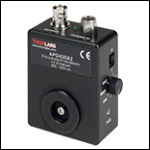
Click to Enlarge
The M Factor is controlled by a knob on the side of the APD.
- Continuously Variable Gain
- Temperature Compensated to Provide M Factor Stability of ≤±3% Over 18 to 28 °C
- Internal SM05 and External SM1 Threads Accept Most Fiber Adapters, Lens Tubes, and Other Components
- Power Supply Included
These Avalanche Photodetectors feature a variable gain that can be controlled by a knob on the right side of the housing. Like the APD130A detectors above, these devices feature an integrated thermistor that maintains an M factor stability of ±3% or better over 23 ± 5 °C by adjusting the bias voltage across the avalanche photodiode. Compared to the standard and temperature-controlled APDs above, the APD430A2 and APD430A detectors also offer a larger usable bandwidth of DC to 400 MHz. The APD410A2 and APD410A detectors offer a slightly smaller usable bandwidth (DC to 10 MHz), but with higher sensitivity. The APD440A2 and APD440A detectors offer high transimpedance gain with a lower max bandwidth of 100 kHz.
The orientation of the mechanical and electrical connections, combined with the compact design, ensures that these detectors can fit into tight spaces. Three 8-32 (M4) mounting holes, one on each edge of the housing, further ensure easy integration into complicated mechanical setups. The housing also provides compatibility with both our SM05- and SM1-Series Lens Tubes. An internally SM1-threaded cap is included.
Fiber Coupling Note:
For fiber-coupled applications, we do not recommend using fiber connector adapters such as Thorlabs' S120-FC with the APD410A2(/M), APD430A2(/M), and APD430A detectors due to the small size of the sensors. High coupling losses and degradation of the frequency response may occur. To achieve high coupling efficiency, a fiber collimation package, focusing lens, and X-Y translator should be used. See the Fiber Coupling tab for details.

Applications
- Fast Laser Pulses
- Ultra-Low-Light Signals
- Temperature-Compensated Avalanche Photodiode
- Integrated Radio Frequency Amplifier
- Continuously Adjustable Gain Setting
- Long-Term Field Tested
- Free-Space Optical Input with Internal SM05 (0.535"-40) Threading
- Easy-to-Use Package
- Location-Specific (EU or US) Power Supply Included
Originally developed for the detection of the beat note signal between CW or pulsed lasers, Menlo Systems' Si Avalanche Photodetectors are ideally suited for applications requiring very high sensitivity for low-light input signals in the 200 - 1000 nm or 400 - 1000 nm range. The APD avalanche photodiode series can provide an extremely sensitive alternative to traditional PIN photodiodes. They are also fast enough for the characterization of, for example, pulsed solid-state lasers on the nanosecond time scale.
The detectors maintain high gain stability over the 10 °C to 40 °C temperature range by utilizing a temperature compensation circuit, which adjusts the ~150 V DC bias to ensure operation near the breakdown voltage.
Models for both the visible and near infrared range are available. The compact design of these detectors allows for easy OEM integration.
The units are especially recommended for applications such as metrology when homodyne or heterodyne optical beat signals of weak power have to be detected and amplified in a highly efficient way.

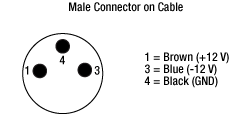
- Replacement Power Supply for Avalanche Photodetectors Sold Above (Except Item # APD210)
- ±12 VDC Power Output
- Current Limit Enabling Short Circuit and Overload Protection
- On/Off Switch with LED Indicator
- Switchable AC Input Voltage (100, 120, or 230 VAC)
- 2 m (6.6 ft) Cable with LUMBERG RSMV3 Male Connector
- UL and CE Compliant
The LDS12B ±12 VDC Regulated Linear Power Supply is intended as a replacement for the supply included with our APD series of avalanche photodetectors sold on this page, except for the APD210 photodetector. The cord has three pins: one for ground, one for +12 V, and one for -12 V (see diagram above). This power supply ships with a location-specific power cord. This power supply can also be used with the PDA series of amplified photodetectors, PDB series of balanced photodetectors, PMM series of photomultiplier modules, and the FSAC autocorrelator for femtosecond lasers.

- Internally SM1-Threaded (1.035"-40) Disks with FC/PC, FC/APC, SMA, ST®*/PC, SC/PC, LC/PC, or Ø2.5 mm Ferrule Receptacle
- Light-Tight Construction when used with SM1 Lens Tubes
These Fiber Adapters can be used with many of our avalanche photodetectors above. Note that we do not recommend using fiber connector adapters alone to couple light onto the APD401A2(/M), APD430A2(/M), and APD430A(/M) avalanche photodetectors due to the small size of their sensors. To achieve high coupling efficiency, a fiber collimation package, focusing lens, and X-Y translator should be used. See the Fiber Coupling tab for details.
The FC/PC and FC/APC adapters are available in narrow or wide key versions; for details on narrow versus wide key connectors, please see our Intro to Fiber tutorial.
The FC/APC adapters have two dimples in the front surface that allow them to be tightened with the SPW909 or SPW801 spanner wrench. The dimples do not go all the way through the disk so that the adapter can be used in light-tight applications when paired with SM1 lens tubes.
The S120-25 ferrule adapter is designed without a locking connector mechanism and accepts fiber patch cables with Ø2.5 mm ferrules for quick measurements with photodetectors or power sensors.
*ST® is a registered trademark of Lucent Technologies, Inc.
 Products Home
Products Home

















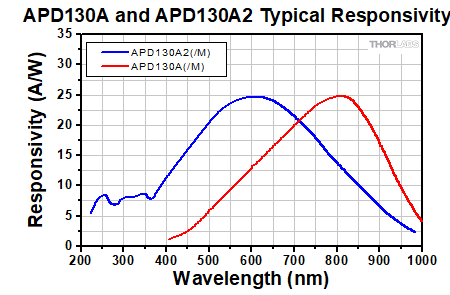
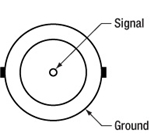

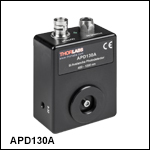
 Zoom
Zoom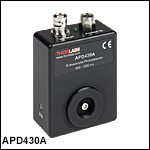
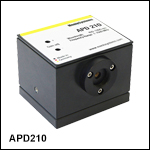
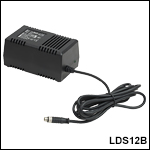









 Si Avalanche Photodetectors
Si Avalanche Photodetectors